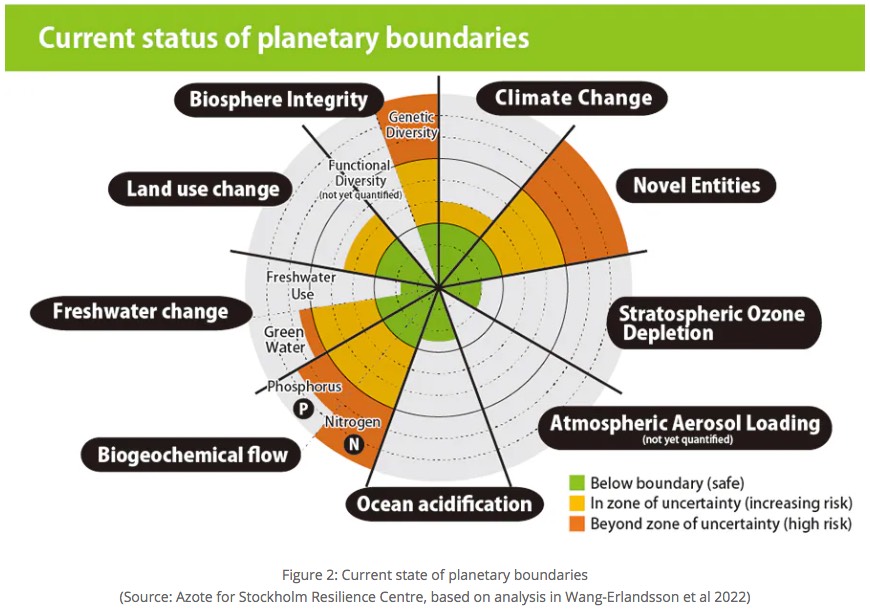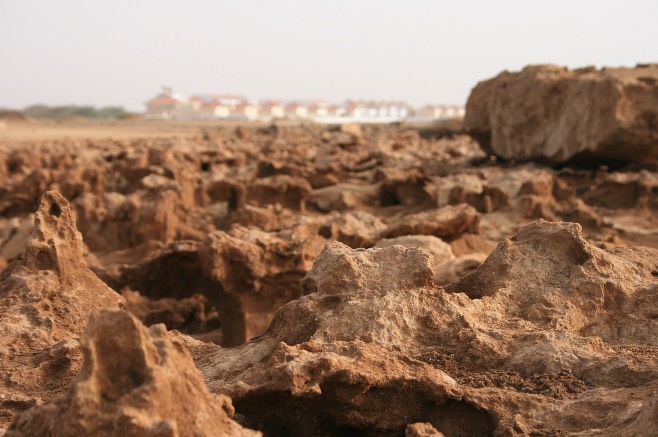What are the 9 planetary boundaries?
In the grand tapestry of Earth’s existence, there are certain boundaries that define the safe operating space for humanity.
These boundaries, known as planetary boundaries, encompass critical environmental thresholds that, if crossed, could lead to irreversible changes in our planet’s systems.
In this article, you’ll delve into these 9 limits, exploring their definitions, major challenges, and real-world examples that highlight the urgency of respecting them.
And you know what? Only 3 planetary boundaries are not already passed, let’s find them out:

We have passed the safety threshold for all of the planetary boundaries apart from ocean acidification, stratospheric ozone depletion, and air pollution (atmospheric aerosol loading, not yet quantified in 2024).
Focus in French about the current status of the nine planetary boundaries

The concept of the nine planetary boundaries was introduced to provide a scientific framework aimed at identifying the environmental limits beyond which humanity cannot safely operate. This framework was proposed in 2009 by a group of 28 scientists led by Johan Rockström from the Stockholm Resilience Centre and Will Steffen from the Australian National University. The primary goal was to define critical thresholds for key processes that regulate the stability and resilience of the Earth’s system.
1 – Climate change
Climate change is perhaps the most widely recognized planetary boundary.
What is climate change, an expression that is repeated everyday?
Climate change refers to the long-term alteration of temperature and typical weather patterns in a place.
The primary challenge lies in the increase of greenhouse gas emissions, primarily carbon dioxide. These gas emissions result from human activities such as burning fossil fuels (oil, gas, and coal) and deforestation. Real-world examples include the melting of polar ice caps, extreme weather events like hurricanes and droughts, and shifts in agricultural patterns affecting food security.
2 – Biodiversity loss
Biodiversity loss encompasses the decline in the variety and abundance of species within a particular ecosystem. There is not one biodiversity but there are biodiversities.
Human activities such as habitat destruction, pollution, overexploitation, and introduction of invasive species contribute to this phenomenon.
Major challenges include the extinction of species, disruption of ecosystem services like pollination and water purification, and loss of genetic diversity essential for resilience.
Examples include the dwindling populations of iconic species like elephants and tigers, and the collapse of coral reefs due to ocean acidification.
3 – Nitrogen and phosphorus cycle
Excessive nitrogen and phosphorus inputs into ecosystems disrupt natural nutrient cycles, leading to pollution and ecosystem degradation.
Agricultural runoff, industrial processes, and sewage discharge are primary sources of these pollutants. Challenges include eutrophication of water bodies, harmful algal blooms, and the creation of oxygen-depleted dead zones.
Real-world examples include the Gulf of Mexico’s “Dead Zone” caused by fertilizer runoff from the Mississippi River and the decline of fish populations due to oxygen depletion.
4 – Land system change
Land system change involves alterations in land use, such as deforestation, urbanization, and conversion of natural habitats for agriculture or infrastructure development. If you want to read further, have a look at our soil erosion article.
The major challenge is the loss of biodiversity-rich ecosystems and their services, along with the release of stored carbon into the atmosphere.
Examples include the Amazon rainforest’s rapid deforestation for cattle ranching and soy cultivation, leading to habitat loss for countless species and contributing to climate change.
5 – Freshwater use
Freshwater use refers to the extraction and consumption of freshwater resources for various human activities, including agriculture, industry, and of course domestic use.
The challenge lies in unsustainable water extraction rates, leading to water scarcity, depletion of aquifers, and deterioration of freshwater ecosystems.
Real-world examples include the depletion of the Ogallala Aquifer in the United States due to intensive agricultural irrigation and the drying of rivers and lakes worldwide due to over-extraction.
6 – Ocean acidification
This is for me the scariest planetary boundary noun, not because all the others are less important but rather that it could be the title of a scary movie or serie. Authors, directors and producers, be ready to go on this passionate matter, please, sensibilise the whole world!
I am very impacted by ocean acidification given that I eventually discovered the immensity of salty water and its role in the balance of Planet Earth, regarding CO2 absorption, biodiversities, mix of green and blue waters, and the ratio land Vs. salty water.
Ocean acidification is the decrease in pH levels of the Earth’s oceans, primarily caused by the absorption of carbon dioxide from the atmosphere.
This phenomenon poses a significant challenge to marine life, particularly organisms with calcium carbonate shells or skeletons, such as corals and shellfish.
Examples include the bleaching of coral reefs due to increased acidity and the disruption of marine food webs as key species struggle to adapt.
7 – Stratospheric ozone depletion
Stratospheric ozone depletion refers to the reduction of the ozone layer in the Earth’s stratosphere, primarily due to the release of ozone-depleting substances like chlorofluorocarbons (CFCs) and halons.
The major challenge is the increased exposure of living organisms to harmful ultraviolet (UV) radiation, leading to skin cancer, cataracts, and damage to ecosystems.
Real-world examples include the Antarctic ozone hole and the recovery efforts following the implementation of the Montreal Protocol.
8 – Atmospheric aerosol loading
Atmospheric aerosol loading involves the release of fine particles and droplets into the atmosphere. Primarily they come from human activities such as industrial processes, transportation, and biomass burning.
The challenge lies in the impact of aerosols on human health, air quality, and climate change.
Examples include smog in urban areas, which contributes to respiratory illnesses, and the formation of haze from forest fires, affecting visibility and regional climate patterns.
9 – Chemical pollution
Chemical pollution refers to the release of harmful synthetic chemicals into the environment, including pesticides, industrial pollutants, and household chemicals.
The major challenge is the widespread contamination of air, water, soil, and food, posing risks to human health and ecosystems.
Real-world examples include the contamination of water bodies with mercury from industrial processes, leading to bioaccumulation in fish and potential health risks for consumers.
Conclusion
The planetary boundaries framework provides a holistic perspective on the complex interactions between human activities and the Earth’s systems.
Respecting these 9 planetary boundaries is crucial for safeguarding the stability and resilience of planet Earth and ensuring a sustainable future for generations to come.
By understanding the definitions, challenges, and real-world examples of each limit, we can collectively strive towards more responsible stewardship of our shared planet Earth home.
Spread relentlessly the message worldwide, and take the time to explain to your friends and family what the 9 planetary boundaries are made of.
Here are the reasons why these planetary boundaries were established:
- Prevent Irreversible Environmental Changes: By defining boundaries, scientists aim to prevent environmental disturbances that could cause irreversible changes to the Earth’s ecosystems.
- Ensure a Safe Operating Space for Humanity: The boundaries are designed to delineate a “safe” zone where human activities can occur without compromising the natural systems that support life.
- Promote Global Environmental Governance: The concept of planetary boundaries provides a scientific basis for guiding international policies and fostering global cooperation in environmental management.
- Raise Awareness and Educate: Clearly identifying critical thresholds helps to raise awareness among policymakers, businesses, and the public about environmental risks and the importance of sustainability.
- Address the Challenges of the Anthropocene: We are in a geological epoch where human activity has become the dominant force of change in the Earth’s environment. The planetary boundaries help to measure and manage this influence.
The nine identified planetary boundaries are as follows:
- Climate Change: Concentrations of greenhouse gases in the atmosphere.
- Biodiversity Loss: Rates of species extinction and decline in populations.
- Biogeochemical Flows: Disruptions in the nitrogen and phosphorus cycles.
- Land-System Change: Deforestation and conversion of natural lands.
- Freshwater Use: Global consumption of freshwater resources.
- Ocean Acidification: Changes in the pH levels of the oceans.
- Stratospheric Ozone Depletion: Concentrations of ozone in the stratosphere.
- Atmospheric Aerosol Loading: Concentration of particulate matter in the atmosphere.
- Introduction of Novel Entities: Release of new chemicals and materials into the environment.

Fabrice Delobette
CSR, sustainability & biodiversity popularizer

